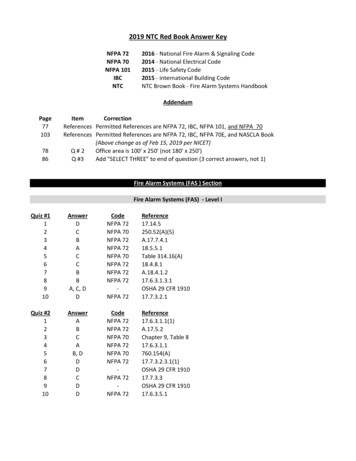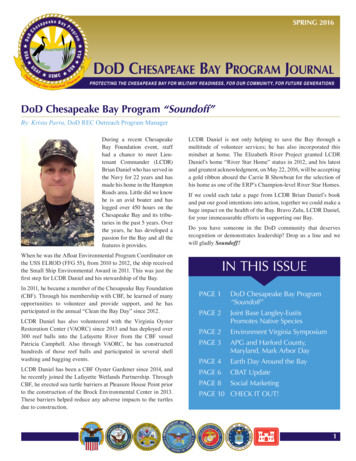
Transcription
ReferencesReferencesAAaras, A., Fostervold, K. I., Ro, O., Thoresen, M., & Larsen, S. (1997). Postural load during VDU work: A comparison betweenvarious work postures. Ergonomics, 40(11), 1255-1268.Alexander, D. C. (1994). The top ten ways ergonomics programs fail. Auburn Engineers, Inc.Ameida, S., Williams, K., Shaffer, R., & Brodine, S. (1998). An epidemiologic study of the association between patterns ofphysical training and musculoskeletal injuries. San Diego, CA: Naval Health Research Center.Amell, T. K., Kumar, S., Narayan, Y., & Coury, H. C. (2000). Effect of trunk rotation and arm position on gross upper extremityadduction strength and muscular activity. Ergonomics, 43(4), 512-527.American Conference of Governmental Industrial Hygienists. (1987). Ergonomic interventions to prevent musculoskeletalinjuries in industry. Lewis Publishers.American Conference of Governmental Industrial Hygienists. (2001). Hand activity level TLV Physical Agents (7th ed.).ACGIH.American Industrial Hygiene Association. (1994). Cumulative trauma disorder of the hand and wrist: An ergonomics guide.AIHA.American Industrial Hygiene Association. (1996). AIHA National Conference Papers. Platform Sessions, Papers 19-24, 5863, 166-173, 180-185.American Industrial Hygiene Association. (1996). AIHA National Conference Papers. Case Studies, Papers 93-96.American Industrial Hygiene Association. (1996). AIHA National Conference Papers. Poster Studies, Papers 404-412.American Industrial Hygiene Association. (1996). American Industrial Hygiene Conference and Exposition ProfessionalDevelopment Course 401 - A Cost-Effective Guide to Office.American Industrial Hygiene Association. (1997). AIHA National Conference Papers. Case Studies, Papers 31-35, 106.American Industrial Hygiene Association. (1997). AIHA National Conference Papers. Platform Sessions, Papers 230-240.American Industrial Hygiene Association. (1997). AIHA National Conference Papers. Poster Series, Articles 310-315.American Industrial Hygiene Association. (1998). AIHA National Conference Papers. Platform Sessions, 56-68, 112-119,292-298, 299-304.American Industrial Hygiene Association. (1998). AIHA National Conference Papers. Case Studies, Papers 25-32.American Industrial Hygiene Association. (1999). AIHA National Conference Papers. Poster Sessions, Papers 369-370.American Industrial Hygiene Association. (1999). AIHA National Conference Papers. Case Studies, Papers 460-464.American Industrial Hygiene Association. (1999). AIHA National Conference Papers. Platform Sessions, Papers 46-51, 113120, 202-208.American Industrial Hygiene Conference & Exposition. /ProgramTools/Resources/References.htm[9/7/2011 2:07:39 PM]
ReferencesAmerican Industrial Hygiene Conference & Exposition. (1998).American Medical Association. (1999). Current procedural terminology. AMA.American Society for Surgery of the Hand. (1990). The hand, examination and diagnosis. Churchill Livingstone.American Society for Surgery of the Hand. (1990). The hand, primary care of common problems. Churchill Livingstone.American Society for Surgery of the Hand. Regional review course in hand surgery. PUBLISHER.Amoroso, P. J., Bell, N. S., Baker, S. P., & Senier, L. (1999). Injury Control Part I: Understanding injuries in the militaryenvironment. Military Performance Division, USARIEM.Amoroso, P. J., Reynolds, K. L, & Barnes, J. A. (1996). Tobacco and injury: An annotated bibliography. JAMA.Anderson, J., Weidermann, S., Heinen, D., Adeoye, B. F., & Beasley, S. (1994). Evaluating office environments: A case study.USACERL.Annett, J., & Stanton, N. A. (2000). Task analysis. Taylor & Francis.ANSI Z-365. (2000). Control of work-related musculoskeletal disorders. American National Standard Institute.Anton, D., Rosecrance, J., Merlino, L., & Cook, T. (2002). Prevalence of musculoskeletal symptoms and carpal tunnelsyndrome among dental hygienists. Am J Ind Med, 42(3), 248-257.Apts, D. W. (1992). Back injury prevention handbook. Lewis Publishers, Inc.AR 40-10. (1991). Health Hazard Assessment Program in Support of the Army Materiel Acquisition Decision Process.Washington, DC: Headquarters Department of the Army.Armstrong, T. J., & Lackey, E. A. (1994). Cumulative trauma disorders of the hand and wrist: An ergonomics guide. AIHA.Arndt, C., Yuan, H., & Hourani, L. (1997). Aircraft type and diagnosed back disorders in U.S. Navy pilots and aircrew. AviatSpace Environ Med, 68.Association for the Advancement of Medical Instrumentation. (2001). Resource Catalog - Standards, RecommendedPractices, and More.Auburn Engineers. (1997). Ergonomics Design Guidelines. (1997). Auburn Engineers, Inc.Author. (1994) Resource Manual for Ergonomics - Version 1.3. Humantech, Inc. NEED AUTHORAuthor. (2000). Because one size does not fit all. Michigan Engineering. NEED MORE INFOAuthor. (2000). Bolt-on back pain remedy. SUSPA, Incorporated. COULD NOT FIND ANYTHINGAyoub, M. M., & Mital, A. (1998). Manual materials handling. Taylor & Francis.BBabski, K. L. (2000). Quantification of the exposure-response relationships of the primary risk factors for carpal tunnelsyndrome. Dissertation, Mississippi State University.Backaitis, S. H. (1994). Biomechanics of impact injury and injury tolerances of the thorax-shoulder complex. Society ofAutomotive Engineers, Inc.Backs, R. W., & Boucsein, W. (2000). Engineering psychophysiology issues and applications. Lawrence Erlbaum /2011 2:07:39 PM]
ReferencesBaron, S. (1992). Cumulative trauma disorders in MIPS: Baseline Preliminary Report No. 16-4-1992. Safety & HealthAssessment and Research for Prevention (SHARP) Program.Beazly, S. D., & Heinen, D. C. (1994). Evaluating office environments: Overall survey results for the Corps of EngineersAlbuquerque District. USACERL.Beek, A. J., Gaalen, L. C., & Frings-Dresen, M. H. W. (1992). Working postures and activities of lorry drivers: A reliability studyof on-site observation and recording on a pocket computer. Applied Ergonomics, 23(5), 331-336.Bergqvist, U., Wolgast, E., Nilsson, B., & Voss, M. (1995). The influence of VDT work on musculoskeletal disorders.Ergonomics, 38(4), 754-762.Berkowitz, S., & Feuerstein, M. (1997). Multivariate predictors of back-related work disability: A prospective investigation.Uniformed Services University of the Health Sciences.Berkowitz, S., Feuerstein, M., Sullivan-Lopez, M., & Peck, C. (1999). Occupational back disability in U.S. Army personnel.Military Medicine, 164, 412-418.Bernard, B. (1997). Musculoskeletal disorders and workplace factors: A critical review of epidemiological evidence for workrelated musculoskeletal disorders of the neck, upper extremity and low back. (NIOSH Publication No. 97-141). DHHS.Boff, K. R., & Lincoln, J. E. (1988). Engineering data compendium: Human perception and performance. Harry G. ArmstrongAerospace Medical Research Laboratory, Wright-Patterson Air Force Base, Ohio.Booz Allen. (1997). The relevance and quality of research on physical ability standards throughout Army militaryoccupational specialties. Booz Allen Hamilton, Inc.Bourque, L. B., & Fielder, E. P. (1995). How to conduct self-administered and mail surveys. Sage Publications, Inc., 3.Bowman, J. D., Kelsh, M. A., & Kaune, W. F. (1998). Manual for measuring occupational electric and magnetic fieldexposures. (NIOSH Publication No. 98-154). Publications Dissemination, EID. NIOSH.Braithwaite, M., Manning J., & Groh, S. (1998). The effect of exposure to the AH-64 Combat Mission Flight Simulator onpostural equilibrium. (USAARL Report No. 98-15). USAARL.Brock, J. R., & Legg, S. J. (1997). The effects of 6 weeks training on the physical fitness of female recruits to the BritishArmy. Ergonomics, 40(3), 400-411.Brophy, M., Achimore, L., & Dawson, J. (2001). Reducing incidence of low-back injuries reduces cost. AIHAJ, 62, 508-511.Brown, O., & Hendrick, H. (1996). Human factors in organizational design and manage-ment –V. Elsevier Science.Bureau of Labor Statistics. (1998). Lost-worktime injuries and illnesses: Characteristics and resulting time away from work.Washington, DC: DOL, 36831.Burgess-Limerick, R., Mon-Williams, M., & Coppard, V. L. (2000). Visual display height. Human Factors and ErgonomicsSociety, 42(1), 140-150.Burke, M. (1992). Applied ergonomics handbook. Lewis Publishers.Burton, W., & Conti, D. (2000). Disability management: Corporate Medical Department management of employee healthand productivity. JOEM, 42, 1006-1012.Butler, B. P., & Allen, N. M. (1997). Long-duration exposure criteria for head-supported mass. (USAARL Report No. 97-34).USAARL.Byrns, G., Bierma, T., Agnew, J., & Curbow, B. (2002). A new direction in low-back pain research. AIHAJ, 63, 55-61.C
ReferencesCacha, C. A. (1999). Ergonomics and Safety in Hand Tool Design. Lewis Publishers.Cacioppo, J., Tassinary, L., & Fridlund, A. (1990). Principles of psychophysiology: Physical, social, and inferential elements.New York: Cambridge University Press.Cailliet, R. (1982). Hand pain and impairment (3rd ed.). F. A. Davis Company.Cailliet, R. (1983). Foot and ankle pain. F. A. Davis Company.Cailliet, R. (1988). Low back pain syndrome. F. A. Davis Company.Cailliet, R. (1991). Neck and arm pain. F. A. Davis Company.Cailliet, R. (1991). Shoulder pain. F. A. Davis Company.Cailliet, R. (1992). Head and face pain syndromes. F. A. Davis Company.Cailliet, R. (1992). Knee pain and disability. F. A. Davis Company.Cailliet, R. (1992). Soft tissue pain and disability. F. A. Davis Company.Cailliet, R. (1993). Pain: Mechanisms and management. F. A. Davis Company.Cailliet, R. (1995). Hand pain and impairment. F. A. Davis Company.Cailliet, R. (1995). Low back pain syndrome. F. A. Davis Company.Capodaglio, P., Capodaglio, E. M., & Bazzini, G. (1997). A field methodology for ergonomic analysis in occupational manualmaterials handling. Applied Ergonomics, 28(3), 203-208.Cardosi, K., & Murphy, E. (1995). Human factors in the design and evaluation of air traffic control systems. Volpe Center.Carnahan, B. J., Redfern, M. S., & Norman, B. A. (2000). Designing safe job rotation schedules using optimization andheuristic search. Ergonomics, 43(4), 543-560.Casey, S. (1998). Set phasers on stun. Aegean Publishing Company.Cekala, S., Beusse, W., Lepore, B., Scire, M., & James, A. (1996). Physically demandingjobs: Services have little data on ability of personnel to perform. Washington, DC: GAO/NSIAD, 96-169.Central Institute for Labour Protection.(1999). The International Ergonomics Association Recognized. International Journal ofOccupational Safety and Ergonomics.Chaffin, D. B., & Anderson, G. B. (1991). Occupational biomechanics. John Wiley & Sons, Inc.Chaffin, D., Faraway, J., Arbor, A., Zhang, X., & Woolley, C. (2000). Stature, age and gender effects on reach motion postures.Human Factors, 42, 408-420.Chapanis, A. (1999). The Chapanis Chronicles 50 years of human factors research, education, and design. AegeanPublishing Company.Charash, R. A. (1990). Ergo analyzer handbook. ErgoDynamics Inc.Charney, W., & Schirmer, J. (1993). Essentials of modern hospital safety. Lewis Publishers, 2.Charteris, J. (1998). Comparison of the effects of backpack loading and of walking speed on foot-floor contact patterns.Ergonomics, 41(12), 1792-1809.Cherkin, D., Eisenberg, D., Sherman, K., Barlow, W., Kaptchuk, T., Street, J., & Deyo, R. (2001). Randomized trial comparingtraditional Chinese medical acupuncture, therapeutic massage, and self-care education for chronic low back pain. Arch InternMed, 161, 1081-1088.Chibnall, J. T., Tait, R. C., & Merys, S. C. (2000). Disability management of low back injuries by employer-retained physicians:
ReferencesRatings and costs. Am J Ind Med, 38(5), 529-538.Christensen, W. C., & Manuele, F. A. (1999). Safety through design. National Safety Council.Churchille, E., McConville, J. T., Laubach, L. L. Churchill, T., Erskine, P., & Downing, K. (1978). Anthropometric Source Book Volume II: A Handbook of Anthropometric Data. (NASA Reference Publication 1024). NASA, Scientific and TechnicalInformation Office.Ciriello, V. M., McGorry, R. W., & Martin, S. E. (1999). Maximum acceptable forces of dynamic pushing: Comparison of twotechniques. Ergonomics, 42(1) 32-39.Clayberg, H. D. (1949). Pathologic physiology of truck and car driving. The Military Surgeon, 299-311.Clements-Croome, D. (2000). Creating the Productive Workplace. E&FN Spon - Taylor & Francis Group - London and NewYork, 360.Cognitive ergonomic, computers, and communications (volume 1). NEED MORE INFOCohen, A., Gjessing, C., Fine, L., Bernard, B., & McGlothlin, J. (1997). Elements of ergonomics programs, a primer based onworkplace evaluations of musculoskeletal disorders.DHHS (NIOSH)Committee on Human Factors. (1999). Work-related musculoskeletal disorders report, workshop summary, and workshoppapers. National Academy Press.Connolly, V., Pritchard, A., Bergeron, A., Mays, M., & Rice, V. (2002). Measurement of the effectiveness of a screening tool todetect injuries and improve readiness among combat medic students. US Army Medical Department Center and School, FortSam Houston, TX.Consultants in Occupational Ergonomics. (2000). Applied Laboratory Ergonomics Manual. Humantech, Inc.Consultants in Occupational Ergonomics. (2000). Applied Office Ergonomics Manual. Humantech, Inc.Consultants in Occupational Ergonomics. (2000). Ergonomic Design Guidelines for Engineers Manual. Humantech, Inc.Corlett, E. N. (1992). RULA-New Self Assessment Tool to Measure Upper Limb Disorder Hazards. Performix News.Cowan, D., Jones, B., & Robinson, J. (1993). Foot morphologic characteristics and risk of exercise-related injury. Arch FamMed, 2, 773-777.CPA. The Workplace Ergonomics Workbook. NEED MORE INFORMATIONCriteria for analyzing and reducing WMSD hazards for employers who choose the specific performance approach. (DATE).General Occupational Health Standards. The only thing I could find with this title was Appendix B of a Washington State'sErgonomics Rule in 2000Crumpton-Young, L., Killough, K., Parker, P., & Brandon, K. (2000). Quantitative analysis of cumulative trauma risk factorsand risk factor interactions. JOEM, 42, 1013-1020.CTDNEWS Workplace Solutions for Repetitive Stress Injuries. [on-line] Available from http://ctdnews.comCTDNEWS. (1996). Preventing back injury. CTDNEWS/LRP Publications.CTDNEWS. (1997). Preventing repetitive strain injuries at your computer workstation. CTDNEWS/LRP Publications.DDainoff, M. (1995). IRS Contract Ergo Intervention Study. Marvin Dainoff Associates, Inc.
ReferencesDean, A.G., Dean, J. A., Burton, A. H., et al. (1994). Version 6. A word processing, database and statistics system forepidemiology on microcomputers. CDL, Atlanta, Georgia.Dempsey, P.G., & Hashemi, L. (1999). Analysis of workers' compensation claims associated with manual materials handling.Ergonomics, 42(1), 183-195.Department of Defense. (1987). Military handbook: Human engineering procedures guide. (DoD-HDBK-763). Washington,DC: U. S. Government Printing Office.Department of Defense. (1989). Human Engineering Design Criteria for Military Systems, Equipment and Facilities. (MILSTD-1472D) Washington, DC: DoD.Department of Defense. (1993). Textbook of Military Medicine (Occupational Health): The Soldier and the Industrial Base).Washington, DC: OTSG.Department of Defense. (1995). DoD Human Computer Interaction (HCI) Concept Plan (Revised). DoD.Department of Defense. (1996). Department of Defense Human Factors Engineering Technical Advisory. Washington, DC:DoD. NOT SURE: I found HFETA Group. Is this referring to a 1996 meeting of the group?Department of Defense. (1996). Military Compensation Background Papers (5th ed.). Office of the Secretary of Defense,Washington, DC: US Government Printing Office.Department of Defense. (1999). Human Engineering Design Criteria Standard. (MIL-STD-1472F). Washington, DC: DoD.Department of Defense. (2001). Assessing Programs for Injury/Occupational Illness Prevention Practices and Initiatives.DoD Injury/Occupational Illness Prevention Committee.Department of Defense. (2001). Best Practice Approaches in Injury/Occupational Illness Surveillance, Research,Intervention, Models, and Prevention. DoD Injury/Occupational Illness Prevention Committee.Department of Defense. (DATE). Injury/Unemployment Compensation Data Medical Cost and Compensation Cost by ICD-9Codes. Civilian Personnel Management System. COULD NOT FINDDepartment of Defense. Department of Defense Telephone Directory. Defense Telecommunications Services.Department of Health and Human Services. (2002). Health, United States, 2002, with Chartbook on Trends in the Health ofAmericans. DHHS - Centers for Disease Control and Prevention.Department of Industrial Relations. (1999). Easy Ergonomics, A Practical Approach for Improving the Workplace. CaliforniaDepartment of Industrial Relations.Department of Labor. (1988). Publication CA-550, Federal Injury Compensation: Questions and Answers about the FederalEmployees' Compensation Act. . Washington, DC: U.S. Government Printing OfficeDepartment of the Army. (1985). USACHPPM Memorandum No. 40-10, NEED TITLE. USACHPPM.Department of the Army. (1992). United States Army: Lifting Manual and Hands and Arms Manual. Washington, DC:Washington Ergonomics.Department of the Army. (1995). Economic Analysis Manual. US Army Cost and Economic Analysis Center.Department of the Army. (1997). Cost Analysis Manual. US Army Cost and Economic Analysis Center.Department of the Army. (1997). Textbook of Military Medicine (Medical Aspects of Chemical and Biological Warfare).Washington, DC: OTSG.Department of the Army. (1997). Total Army Injury and Health Outcomes Database: Description and Capabilities. USARIEM.Department of the Army. (1998). FM 100-14: Risk Management. Washington, DC: Headquarters Department of the Army.Department of the Army. (1998). Risk Management. Washington, DC: Headquarters Department of the Army.Department of the Army. (2000). 225 years of the U.S. Army. Faircount, LLC.
ReferencesDepartment of the Army. (2000). Carpal tunnel syndrome among US soldiers, 1998-1999. Medical Surveillance MonthlyReport.Department of the Army. (2002). Army Regulation 40-3: Medical, Dental, and Veterinary Care. Washington, DC:Headquarters Department of the Army.Department of the Army. (DATE). AMEDD Staff Action Guide. Washington, DC: Headquarters Department of the Army.COULD NOT FINDDepartment of the Army. (DATE). An Industrial Ergonomics Bibliography: Prevention of Cumulative Trauma ThroughWorkplace Analysis. USARIEM. COULD NOT FINDDepartment of the Army. (DATE). Basic Course in Occupational Medicine. USACHPPM. COULD NOT FINDDepartment of the Army. (DATE). Injury Control Part II: Strategies for Prevention. USAMRMC. COULD NOT FINDDepartment of the Army. (DATE). The Effects of Backpack Weight on the Biomechanics of Load Carriage. USARIEM. COULDNOT FINDDeyo, R. A., & Weinstein, J. N. (2001). Low back pain. N Engl Med, 344(5), 363-371.Dieen, J., & Toussaint, H. (1997). Evaluation of the probability of spinal damage caused by sustained cyclic compressionloading. Human Factors, 39(3), 469-480.Dimov, M., Bhattacharya, A., Lemasters, G., & Atterbury, M. (2000). Exertion and body discomfort perceived symptomsassociated with carpentry tasks: An on-site evaluation. AIHAJ, 61, 685-691.Division of Environmental Health. (1996). Evaluating Occupational Safety & Health & Workers' Compensation Programs.PUBLISHERDoD 5000.2-R. (1996). Mandatory Procedures for Major Defense Acquisition Programs (MDAPs) & Major AutomatedInformation System (MAIS) Acquisition Programs. Washington, DC: DoD.Donnelly, J. E. (1990). Living anatomy. Human Kinetics Books.Droke, D., Albright, P., Toy, K., Podschun, G., & Rudolph, A. (1993). Public health reports. Journal of the U.S. Public HealthService, 108.Dul, J., & Weerdeester, B. (1993). Ergonomics for beginners: A quick reference guide. Taylor & Francis.Dupuis, H. (1994). Medical and occupational preconditions for vibration-induced spinal disorders: Occupational disease No.2110 in Germany. Int Arch Occup Environ Health, 66, 303-308.EEarth Tech, Inc. (1996). Final risk factor/discomfort survey development pretest survey report HQ Space Command. COULDNOT FINDEbadian, M., Allen, M., Krummen, W., & Tucker, T. (2000). A technical guide for performing ROI analyses of USAF workplaces(Final Report). Florida International University.Ehrlich, R. J. (2003). Chapter 11, CALL Newsletter No. 01-15, Soldier's load and combat readiness. Joint Readiness TrainingCenter, Operations Group, Task Force.Ergonomics Program University of California. (1998). Estimating muscle load using surface EMG amplitude. MarconiResearch Conference 1998.Estill, C. F., McGlothlin, J. D., Hagedorn, R. T., & Flesch, J. P. (1998). Hazard controls: Controlling the ergonomic hazards of
Referenceswiring tasks for household appliances. DHHS (NIOSH) Publication No. 98-108. NIOSH/DHHSFFarrell, G. P., Knowlton, S. K., & Taylor, M. C. Second chance: Rehabilitating the American worker. Unpublished.Fathallah, F. A., & Brogmus, G. E. (1999). Hourly trends in Workers' Compensation claims. Ergonomics, 42(1), 196-207.Feletto, M., & Graze,W. (1997). A back injury prevention guide for health care providers. California: OSHA ConsultationService.Ferguson, S. A., Marras, W. S. & Crowell, R. R. (1996). Dynamic low back functional motion capacity evaluation. Journal ofOccupational Rehabilitation, 6(4), 203-214.Feuerstein, M., & Beattie, P. (1995). Biobehavioral factors affecting pain and disability in low back pain: Mechanisms andassessment. Physical Therapy, 75(4), 267-280.Feuerstein, M., & Hickey, P. F. (1992). Chapter 6. Ergonomic approaches in the clinical assessment of occupationalmusculoskeletal disorders. Handbook of Pain Assessment, 71-99.Feuerstein, M., Berkowitz, S., & Peck, C. (1997). Musculoskeletal-related disability in US Army personnel: Prevalence,gender, and military occupational specialties. JOEM, 39, 68-78.Fink, A. (1995). How to analyze survey data. Sage Publications, Inc.Fink, A. (1995). How to design surveys. Sage Publications, Inc.Fink, A. (2003). How to ask survey questions (2nd ed.). Sage Publications, Inc.Fink, A. (2003). How to report on surveys (2nd ed.). Sage Publications, Inc.Fink, A. (2003). How to sample in surveys (2nd ed.). Sage Publications, Inc.Fink, A. (2003). The survey handbook (2nd ed.). Sage Publications, Inc.Fink, A., & Kosecoff, J. (1998). How to conduct surveys: A step-by-step guide. Sage Publications, Inc.Fleishman, E. (1963). Educational and psychological measurement factor analyses of physical fitness tests. XXIII COULDNOT FINDFleishman, E. (1984). Systems for linking job tasks to personnel requirements. Public Personnel Management Journal,13(40), 395-408.Fleishman, E. (1988). Some new frontiers in personnel selection research. Personnel Psychology, 41.Fleishman, E. A. (DATE). Rating Scale Booklet F-JAS (Fleishman Job Analysis Survey). Management Research Institute, Inc.Fleishman, E., & Reilly, M. (DATE). Administrator's Guide F-JAS (Fleishman Job Analysis Survey). Management ResearchInstitute, Inc.Fleishman, E., Gebhardt, D., & Hogan, J. (1986). The perception of physical effort in job tasks. Perception of Exertion inPhysical Exercise. Macmillan Press Ltd.Fleming, S. L., Jansen, C. W., & Hasson, S. M. (1997). Effect of work glove and type of muscle action on grip fatigue.Ergonomics, 40(6), 601-612.
ReferencesFlexner, S. B. (1987). Random House Dictionary of the English Language [Abridged] (2nd ed.). Random House.Flinchum, R. (2000, Winter). Dreyfuss, design, and human factors. Ergonomics in Design, Q1, 18.Fogleman, M., & Brogmus, G. (1995). Computer mouse use and cumulative trauma disorders of the upper extremities.Ergonomics, 38(12), 2465-2475.Fransson-Hall, C., Gloria, R. Kilborn, A., & Winkel, J. (1995). A portable ergonomic observation method (PEO) forcomputerized on-line recording of postures and manual handling. Applied Ergonomics, 26(2), 93-100.Frey, J. H., & Oishi, S. M. (1995). How to conduct interviews by telephone and in person. Sage Publications, Inc., 4.Friedrich, M., Cermak, T., & Heiller, I. (2000). Spinal troubles in sewage workers: Epidemiological data and work disabilitydue to low back pain. Int Arch Occup Environ Health, 73(4), 245-254.Fulton Suri, J. (2000, Summer). Saving lives through design. Ergonomics in Design, 37723.GGalinsky, T. L., Swanson, N. G., & Sauter, S. L. (2000). A field study of supplementary rest breaks for data-entry operators.Ergonomics, 43(5), 622-638.Gardiner, J., Bradley, C., & Huebner, M. (2000). The cost-effectiveness ratio in the analysis of health care programs.Handbook of Statistics, 18.Gardiner, J., Huebner, M., Jetton, J., & Bradley, C. (2000). Power and sample size assessments for tests of hypotheses oncost-effectiveness ratios. Health Economics, 9, 227-234.Gauf, M. (1998). Ergonomics that work: Case studies of companies cutting costs through ergonomics. LRP Publications.Gawron, V. J. (2000). Human performance measures handbook. Lawrence Erlbaum Associates.Geller, E.S. (1996). Working safe, How to help people actively care for health and safety. Chilton Book Company.Genaidy, A., Beltran, J., Yeung, S., & Karwowski, W. (1999). Use of human expertise in the evaluation of manual liftingactivities. Occupational Ergonomics, 2(2), 105-124.Genaidy, A., Stambough, ?., Yeung, S., Beltran, J., Huston, R., & Karwowski, W. (1999). Application of the human expertisebased model for evaluation of manual lifting tasks in the Hong Kong worker population. Proceedings of the Human Factors andErgonomics Society 43rd Annual Meeting, 1999, 652-655. I couldn't find the initial for StamboughGerr, F., Marcus, M., & Ortiz, D. J. (1996). Methodological limitations in the study of video display terminal use and upperextremity musculoskeletal disorders. Am J Ind Med, 29, 649-656.Gerr, F., Marcus, M., Ortiz, D., White, B., Jones, W., Cohen, S., Gentry, E., Edwards, A., & Bauer, E. (2000). Computer users'postures and associations with workstation characteristics. AIHAJ, 61(2), 223-230.Godnig, E. C., & Hacunda, J. S. (1991). Computers and visual stress: Staying healthy. Abacus Software.Goel, V. K., & Rim, K. (1987). Role of gloves in reducing vibration: An analysis for pneumatic chipping hammer. AIHAJ,48(1), 9-14.Grajewski, B., Schnoor, T. M., & Reefhuis, J. (1997). Work with video display terminals and the risk of reduced birthweightand preterm birth. Am J Ind Med, 32, 681-688.Grandjean, E. (1988). Fitting the task to the man: A textbook of occupational ergonomics (4th ed.). Taylor & Francis.Grandjean, E. (1995). Ergonomics in computerized offices. Taylor & Francis.
ReferencesGrant, C., & Brophy, M. (1994). An ergonomics guide to VDT workstations. AIHA.Grant, K. A., Congleton, J. J., & Koppa, R. J. (1991). Use of motor nerve conduction testing and vibration sensitivity testing asscreening tools for carpal tunnel syndrome in industry. The Journal of Hand Surgery, 17A(1), 71-76.Greenberg, L., & Chaffin, D. (1989). Workers and their tools. Pendell Publishing Company.Guo, H., Tanaka, S., Halperin, W., & Cameron, L. (1999). Back pain prevalence in US industry and estimates of lostworkdays. Am J Public Health, 89, 1029-1035.Guo, L., Genaidy, A., Christensen, D., & Huntington, K. (1996). Macro-ergonomic risk assessment in nuclear remediationindustry. Applied Ergonomics, 27(4), 241-254.HHabes, D. J., & Baron, S. (2000). Ergonomic evaluation of antenatal ultrasound testing procedures. Appl Occup Environ Hyg,15(7), 521-528.Hadler, N. M. (1996). If you have to prove you are ill, you can't get well. Spine, 21(20), 2397-2400.Hadler, N. M. (1996). Regional back pain: Predicament at home, nemesis at work. JOEM, 38(10), 973-978.Hadler, N. M. (1996). Repetitive upper-extremity motions in the workplace are not hazardous. The Journal of Hand Surgery,22A(1), 19-29.Hadler, N. M. (1997). Back pain in the workplace. Spine, 22(9), 935-940.Hagberg, M., Silverstein, B., Wells, R., Smith, R., Carayon, P., Hendrick, H., & Perusse, M. (1995). Work-relatedmusculoskeletal disorders (WMSDs): A reference book for prevention. Taylor & Francis.Hansen, D. J. (1993). The Work Environment, Healthcare, Laboratories, and Biosafety, Volume 2. Lewis Publishers.Harman, E., Han, K. H., Frykman, P., & Pandorf, C. (2000). The Effects of Walking Speed on the Biomechanics of BackpackLoad Carriage. USARIEM.Hashemi, L., Webster, B., Clancy, E., & Volinn, E. (1997). Length of disability and cost of workers' compensation low backpain claims. JOEM, 39.Headley, B. (1993). Controlling symptoms at work, the "C-SAW" program, a program to reduce cumulative trauma at theworksite. Innovative Systems for Rehabilitation. COULD NOT FINDHeadley, B. J. (1992). When working hurts . . . What to do and why. Innovative Systems for Rehabilitation. COULD NOT FINDHeadley, B. J. (1993). Controlling symptoms at work. Innovative Systems for Rehabilitation. COULD NOT FINDHeadley, B. J. (DATE). Controlling symptoms at work: Worksite intervention program for cumulative trauma. InnovativeSystems for Rehabilitation. COULD NOT FINDHeinen, D.C., Demirjian, S. N., Pardon, T. A., & Adeoye, B. F. (1994). The value of interior design. USACERL.Heinen, D. C., Rundus, R. E., Kemme, M. R., Nemeth, R. J., & Kinz, G. R. (1994). How building systems affect workerwellness. USACERL.Hendrick, H. W. (1996). Human Factors in Organizational Design and Management – V. Institute of Safety and Systems
ReferencesManagement.Hendrick, H. W., & Kleiner, B. M. (2001). Macroergonomics an introduction to work system design. Human Factors andErgonomics Society.Hignett, S., & McAtamney, L. (2000). Rapid entire body assessment (REBA). Applied Ergonomics, 31, 201-205.Hignett, S. (2001). Embedding ergonomics in hospital culture: Top-down and bottom-up strategies. Applied Ergonomics,32, 6
Burke, M. (1992). Applied ergonomics handbook. Lewis Publishers. . therapeutic massage, and self-care education for chronic low back pain. Arch Intern Med, 161, . US Army Medical Department Center and School, Fort Sam Houston, TX. Consultants in Occupational Ergonomics. (2000).










